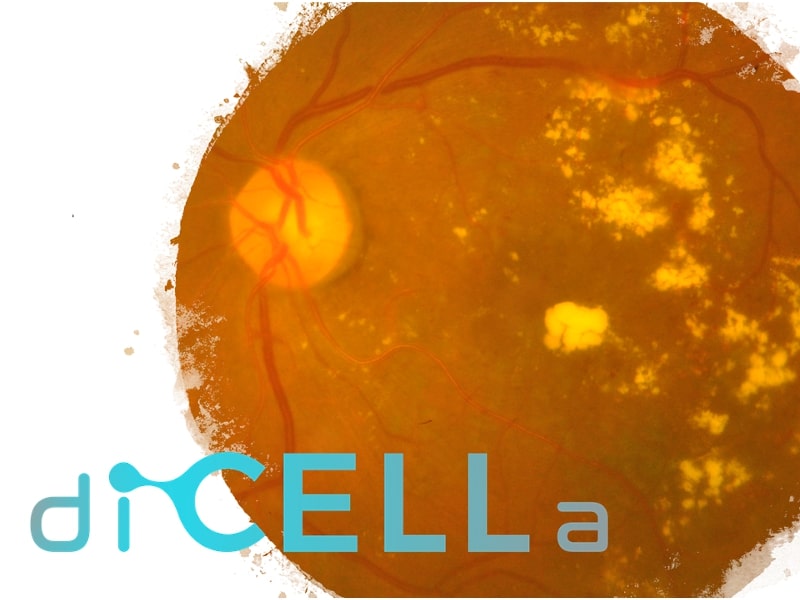diCELLa RETINOPATHY Detection
Diabetes mellitus (DM) is a chronic disease of the 21st century associated with abnormal carbohydrate metabolism. Insulin is a hormone produced by the pancreas that is essential for carbohydrate metabolism. The number of people with diabetes in 2014 was 422 million, of which a significant percentage are believed to be undiagnosed. Diabetes is associated with an increased risk of the following eye diseases: cataracts, open-angle glaucoma and diabetic retinopathy (DMR). With our app, you can quickly classify retinal images into one of four groups: no DMR, mild DMR, moderate DMR or severe DMR. In this way, you can streamline and speed up the diagnosis of DMR.
Effective detection of diabetic retinopathy - try it out!
Effective detection of diabetic retinopathy - try it out!

diCELLa RETINOPATHY Detection
Application for retinal image classification
Application for retinal image classification
Diabetes mellitus (DM) is a chronic disease of the 21st century that involves abnormal carbohydrate metabolism. Insulin is a hormone produced by the pancreas that is essential for carbohydrate metabolism. It is responsible for ensuring that glucose obtained from food is transported from the blood into cells.
In this way, blood sugar levels are lowered and cells are nourished. When insulin levels in the blood are normal, sugar levels are also within normal limits. However, the pancreas may produce too little insulin (type 1 DM) or the body's cells do not use insulin efficiently (type 2 DM).
Uncontrolled glucose levels cause numerous complications in the body, which are mainly related to nerves and small blood vessels [1]. The number of people with DM in 2014 was 422 million, of which a significant percentage are believed to be undiagnosed. Uncontrolled or untreated diabetes is thought to be a leading cause of blindness, kidney failure, heart attacks, stroke and lower limb amputations [1]. Diabetes is associated with an increased risk of the following eye diseases: cataracts, open-angle glaucoma and diabetic retinopathy (DMR). The last of these diseases is the most common cause of blindness. As a result of excessively high blood glucose levels, the retina is damaged. The initial stages of DMR may not have characteristic symptoms, but can eventually lead to vision loss or other serious eye complications, such as diabetic macular edema (DME), neovascular glaucoma or retinal detachment [2]. With our app, you can quickly classify retinal images into one of four groups: no DMR, mild DMR, moderate DMR or severe DMR. In this way, you can improve and streamline the diagnosis of DMR
In this way, blood sugar levels are lowered and cells are nourished. When insulin levels in the blood are normal, sugar levels are also within normal limits. However, the pancreas may produce too little insulin (type 1 DM) or the body's cells do not use insulin efficiently (type 2 DM).
Uncontrolled glucose levels cause numerous complications in the body, which are mainly related to nerves and small blood vessels [1]. The number of people with DM in 2014 was 422 million, of which a significant percentage are believed to be undiagnosed. Uncontrolled or untreated diabetes is thought to be a leading cause of blindness, kidney failure, heart attacks, stroke and lower limb amputations [1]. Diabetes is associated with an increased risk of the following eye diseases: cataracts, open-angle glaucoma and diabetic retinopathy (DMR). The last of these diseases is the most common cause of blindness. As a result of excessively high blood glucose levels, the retina is damaged. The initial stages of DMR may not have characteristic symptoms, but can eventually lead to vision loss or other serious eye complications, such as diabetic macular edema (DME), neovascular glaucoma or retinal detachment [2]. With our app, you can quickly classify retinal images into one of four groups: no DMR, mild DMR, moderate DMR or severe DMR. In this way, you can improve and streamline the diagnosis of DMR
Bibliography:
[1] https://www.who.int/news-room/fact-sheets/detail/diabetes
[2] https://www.nei.nih.gov/learn-about-eye-health/eye-conditions-and-diseases/diabetic-retinopathy
